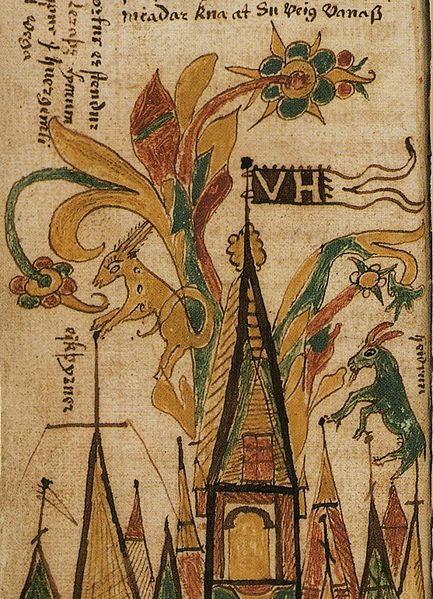The Vikings and their gods had a close relationship with creatures of the animal world. Many of the Aesir and Vanir gods have familiars that accompany them in their greatest exploits. Without these guides, informants, and companions, many of them would have failed to achieve their greatest feats.
The animals themselves are no ordinary beings, but creatures borne into the 9 realms through magic or high pedigree of ancestors.
Here we celebrate some of the most remarkable beasts to grace the Viking fireside tales of the gods.
Alsvin/Allsvinn/Alsvidr, “All Swift”
Two great horses draw the chariot “Alfrödul” of Sunna, the sun goddess, around Midgard each day. One is named Alsvin, the other Arvaker. They are so fleet of foot, that Sköll, the tireless wolf, has never managed to catch them yet.
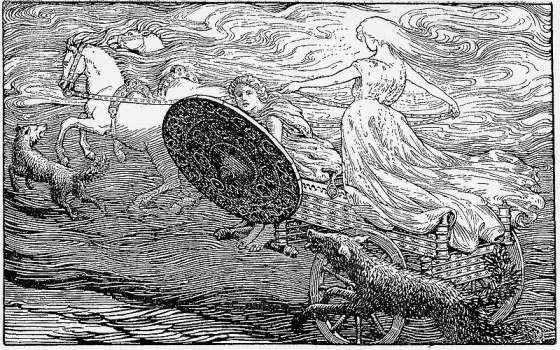
One day, at the time of Ragnarok it will happen, that the wolf will find his prey and the sun will be swallowed whole.
Alsvindr/Alsviðr, “Rapid Goer”
Mani, the moon god, seeks eternally to escape Hati the wolf. Alsvinder, his brave horse, draws his chariot. However, one day, at the end of times, Hati will catch up with his prey and finally devour the moon.
Arvaker/Árvakr, “Early Waker”
Sunna’s chariot requires two horses. Alsvin provides speed but Arvaker provides a daily headstart. Together they keep Sunna and her chariot ever one step ahead of Skoll the wolf.
Dain, Dvalin, Duneyr, and Durathror
Harts, there are also four,
which from its summits,
arch-necked, gnaw.
Dâin and Dvalin,
Duneyr and Durathrôr.
Grimnismál: The Lay of Grimnir” (Thorpe Translation 1866, p. 24)
Four primordial deer inhabit the upper regions of the world tree Yggdrasil. Their names are Dain, Dvalin, Duneyr, and Durathror. Although not familiars of the gods, they are close to Yggdrasil, and therefore provide service to the great tree which is the source of all life.
They are benign, gentle creatures, who live by consuming the leaves of the great tree. Some believe that this contributes gradually to the weakening of the tree that will one day usher in the end times of Ragnarok.
Eikthyrnir, “Oak Thorny”
Eikthyrnir is a most unusual creature. This deer inhabits a place on the roof of Valhalla’s great hall. From this vantage point, he may eat leaves from the Laerrad, the great oak that lives in this place. More importantly, as he eats, drops of water fall from his antlers.
This water from his antlers is abundant and falls into the well Hvergelmir. From there, the water runs into the mighty Élivágar rivers, from which all other rivers form.
Fenrir, Fenrisúlfr “Fenris Wolf”
Fenrir is one of the most fearsome creatures in all Norse myth. This hound is a child of Loki and the giantess Angrboda. He is brother to Jörmungand the Midgard Serpent and Hel, Queen of the Dead.
This vast wolf caused great fear in the gods due to his increasing size. They then tricked him into being bound with unbreakable bonds. Tyr, god of Law lost his hand in the process.
Skoll and Hati who chase the sun and the moon are his children. One day these offspring of Fenrir will devour the heavenly bodies.
He will remain bound on a remote island until his chains are broken at the time of Ragnarok. When released, however, he will rush to aid his father Loki in the destruction of all known things.
His vast maw will devour worlds before he is challenged by Odin. The Allfather will perish in his jaws, he himself, however, shall die by the hand of the Odin-son Vidar.
Freya’s Cats
The beloved Vanir goddess of love, sex, gold, and magic, possesses a chariot to hasten her travels. This chariot is drawn by two large blue-gray tomcats gifted to her by Thor. These felines are so great in size that at times the beautiful goddess, when not astride her golden boar, will ride a single one of them to her destination.
Geri, “Voracious” and Freki, “Violent”
These wolves embody the relationship of the Vikings to the wild animal kingdom like no other. Odin keeps Geri and Freki nearby and feeds them from his own table. They are much more than pets to the Allfather and played a crucial role in the history of his world creation.
One source have them aiding the Valkyries by leading the heroic fallen, chosen by the warrior goddesses, to the great hall of Valhalla.
The love of wolves by the Vikings is deep and ancient. Lord Odin is also said to be a god of wolves and his relationship with these companions is mystical and profound.
Goldfaxi/Gullfaxi, “Golden Mane”
This fine horse was originally owned by Hrungnir the giant. Hrungnir foolishly entered into a wager with Odin as to whose horse was the fastest. While Gullfaxi is certainly a remarkable animal, he was ultimately no match for Sleipnir, Odin’s 8-legged steed.
After the wager is lost Thor dispatches the giant to Helheim. Unfortunately, he becomes trapped under a leg of the deceased jotunn. None can move the limb except for Magni, Thor’s three-days-old son. As a reward for freeing him, Thor gifted Gullfaxi to his son to whom he now belongs.
Gullinbursti, “Golden Bristles”
This wonderful boar was created by two ingenious dwarves to win a bet with Loki. Brokk and Eitri formed this creature from layers of pigskin and fibers of golden wire. The result was a boar faster than any horse of four legs and with the ability to glow like the sun.
Loki lost his bet with the dwarves but Freyr, Vanir god of hunting, fertility, and love gained a shining steed.
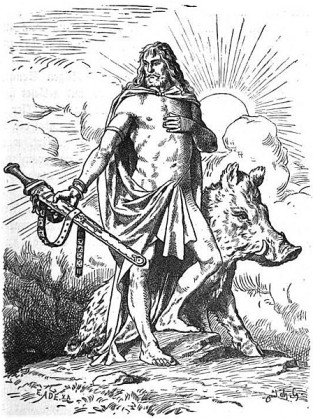
It is said by some that he rode Gullinbursti to Baldur’s funeral. Others say the gleaming boar drew him there in his chariot.
The Roosters of Ragnarok
Three beautiful red roosters will announce the coming of Ragnarok. The first of these is Fjalar, “All Knower”, who will call out to the giants that their time has come to lay siege to Asgard. The second is Gullinkambi, “Golden Comb”, who will alert the gods. The third is unnamed and will call out to the armies of the dead in Helheim.
Gulltopp/Gulltopr, “Golden Mane”
This magical steed belongs to Heimdallr, guardian of Asgard and the Bifrost. Little is known of him, yet we must assume that this was a horse of heroic character to be honored with ownership by so great a god as Heimdallr.
Hati, “Hate”
Hati is the wolf that eternally chases Mani, the moon god, across the sky night after night. He is a child of Fenrir the wolf, a grandchild of Loki. His destiny is to devour the moon at Ragnarok.
Heidrun
A goat called Heiðrún stands up in Valhalla
biting the buds off the branches of that very famous tree which is
called Lærað.
From her teats runs the mead with which every day she fills a cauldron,
which is so big that all the Einherjar can drink their fill from it. –
The Prose Edda, from Young’s translation.
This remarkable goat Heidrun, like many animals in Norse divinity, straddles the definition of god and magical animal. Much of her time she spends eating leaves from the world tree. She has, however, another role more crucial to the gods. It is her gift and duty to brew in her udders the mead that Valhalla’s einherjar drink day after day of their ceaseless feasting and fighting.
Hildisvini, “Battle Swine”
The Vanir goddess Freya possesses a boar similar to that of her brother Freyr. Hildisvini, like Gullfaxi, has gleaming golden bristles. He accompanies the goddess on her important journeys. Dainn and Nabi the dwarves are said to have created this magnificent beast for the goddess of love.
Hrimfaxi, “Frosty Mane”
Odin set Nott and Dagr, night and day, in two chariots to circle Midgard at regular intervals to create the passage of time. The celestial horse Hrimfaxi draws Nott’s chariot each night across the sky.
Huginn, “Thought” and Muninn, “Memory”
These ravens hold the secret to the Allfather’s all-knowing wisdom of the 9 realms. Odin instructed his winged spies in the art of speech and trained them to fly about the world each day.
Every morning he sends out Huginn and Muninn to gather intelligence for his wise decision making. Each evening they return, perch upon his shoulders, and whisper to him all that they have learned.
Jormungand, The Midgard Serpent
Few creatures play such a central role in the annals of the gods as Jorumungand. His body is so great that it encircles all of Midgard. Like Fenrir the wolf, he is a child of Loki, and like his brother, his increasing size caused great fear in Asgard. The gods complained so much that Odin cast the snake to the bottom of the ocean.
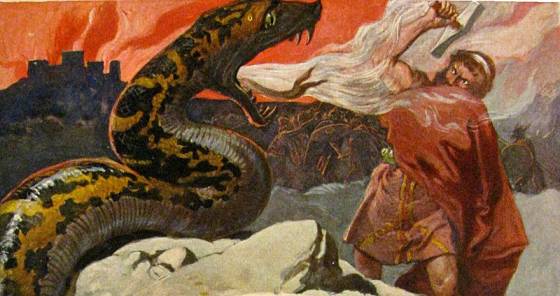
There he resides, slumbering, until Ragnarok when he shall awake to do battle at his father’s side. Prophecy foretells that it is Thor who will win the struggle against vast Jormungand, but at the cost of his own life.
Nidhogg/Nidhug, “Malice Striker”
Nidhogg is a dragon with a sharp tongue as well as a fiery breath. He sits at the base of Yggdrasil, near Helheim, feeding on its roots. His efforts gradually undermine the tree’s strength and hasten the doom of the gods. To entertain himself he sends insults daily to the eagle perched in the high branches of the world tree.
When he is not trading insults or feeding on the world tree, Nidugg feeds on corpses of murderers, thieves and other ne’er do wells of the underworld.
Ratatosk, “Drill Tooth”
Ratatosk is a squirrel with immense abilities. Each day he traverses the full length of Yggdrasil and back again. Few creatures in the 9 realms are capable of such a feat.
He is, however, a gossip who expends all of his magical ability in passing insults back and forth between Nidhugg the corpse-eating dragon, and the mysterious eagle atop the great tree.
Saehrimnir
We must pity this animal as every day, Andhrimir the chef of the gods, slaughters him for the kitchen pot. The cook must prepare a feast for the einherjar after their day of battle, stewing the meat in Eldhrimnir, his cauldron.
The next day, the cook brings the same beast to life once more, to slay and stew him all over again. And so it goes for poor Saehrimnir, a Norse version of the Greek Sysiphus, doomed to rebirth and slaughter each day until Ragnarok may bring him final liberation.
Skinfaxi, “Shining Mane”
Skinfaxi is the tireless steed that draws Dagr’s chariot across the sky each day. These two are the counterparts to Nott and Hrimfaxi who draw the night across the earth in their turn.
Skoll, “Treachery”
Skoll is a child of Fenrir and a grandson of Loki. Desire consumes him, like his brother Hati, for one object. His brother chases Mani in his moon chariot, and Skoll chases Sunna in hers. There will come a day when he eventually succeeds and devours the sun, plunging the worlds into darkness.
Sleipnir
Odin’s eight-legged steed plays a central role in many of his adventures. He is a truly remarkable animal, all the more so as he is yet another scion of Loki.
Though all of his siblings and half-siblings are dark figures, who bring misfortune to the gods, Sleipnir breaks the mold. When the Allfather needs him most, Sleipnir is always there.
His father was a magical steed belonging to the nameless jotunn who constructed Asgard’s great wall. We remember the horse, however, more than his master.
Loki risked the loss of the goddess Freya in a reckless bet with the giant. The gods compelled him to reverse the misfortune by any means possible. To achieve his goal Loki transformed himself into a mare to tempt away the hard-working Svadilfari.
His mission was a success and after a night of passion with the giant horse, Loki was ripe with child. The trickster god became the mother of a beautiful gray, eight-legged stallion. This horse, fleeter than all other creatures, is none other than Sleipnir, Odin’s loyal warrior steed.
Svadilfari
This magnificent horse plays a crucial role in the destiny of Asgard. Once a workhorse to a giant, he outdid his master in the construction of Asgard’s protective wall.
The gods saw that they must limit Svadilfari’s progress, or they would surely lose Freya. Loki used his shape-shifting powers to transform himself into a beautiful mare which Svadilfari mounted lustily when he should have been building.
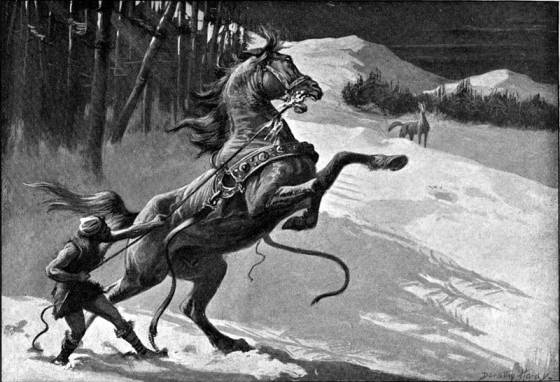
This is the only creature in all the 9 realms who can lay claim to impregnating the trickster god Loki.
Their child is Sleipnir, who is Odin’s steed and hero of more than one of the great tales of the Norse gods.
Tanngnjostr and Tanngrisnir
Tanngniost/Tanngnjostr or “Teeth Barer” and Tanngrisnir, or “Teeth Grinder” are the pair of goats who draw Thor’s mighty chariot. They move the heavenly vehicle so rapidly that flashes of lightning fly out from under the wheels.
Despite their loyal service to Thor, the thunder god repeatedly slaughters and feasts on his companions. This only occurs, however, when Thor is away from Asgard and requires sustenance for his journey. Once they are consumed the thunder god calls upon his mystical Hammer Mjolnir to revive the beasts for another day’s travel, and perhaps, another feast.

